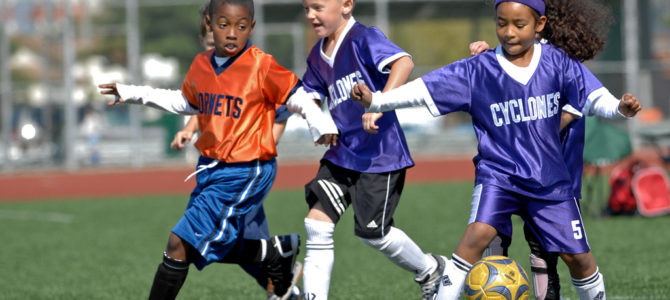
I recently discussed the threat of chronic traumatic encephalopathy to football, the National Football League in particular. While football faces the most immediate threat from CTE, it’s far from the only contact sport that must face this issue.
Soccer may be the next sport to deal with the fallout of brain trauma and CTE. Former Ireland and Colorado Rapids forward Kevin Doyle’s recent concussion-enforced retirement kicked off a new round of discussions regarding soccer and the brain.
Soccer may lack the constant blows of football, yet it still sees plenty of head injuries and concussions. Female soccer players suffer the most concussions in high school sports, according to the American Academy of Orthopaedic Surgeons. Heading plays a big role in the sport and produces a similar sort of brain sloshing as subconcussive hits in football.
Too Little Care for Concussions
World soccer exhibits far too little caution over concussions. Fédération Internationale de Football Association (FIFA) didn’t even follow its own concussion guidelines at the 2014 World Cup, according to Canadian researchers. Players return to the field too often after serious head injuries, with Christopher Kramer at the 2014 World Cup final and Hugo Lloris in a Premier League match serving as recent high-profile examples.
Major League Soccer hasn’t avoided the issue either. Concussions remain a dicier problem for soccer than football, considering its substitution limits. Managers don’t want to burn one of their three substitutions if it’s “just a knock,” especially if it involves a goalkeeper like in Lloris’ case. They also don’t want to play down a man for too long so a player can receive a proper examination. So they generally fall on the side of playing rather than safety.
FIFA has implemented a three-minute break in a game if a brain injury is suspected. But that’s simply not sufficient to determine a concussion.
What’s Wrong with Heading
While concussions remain a serious issue for the sport, heading may cause the more widespread brain issues. Not everyone experiences a concussion while playing soccer. Everyone heads the ball, more often in practice than in games.
One small study found that frequent heading caused brain changes “resembling mild traumatic brain injury,” the kind that resembles the subconcussive hits of football. Other studies have found a connection between soccer or heading and “structural changes to the brain.”
Unfortunately, soccer hasn’t gleaned (or rued) nearly the brain data that football has. It also lacks the “big name” diagnoses, like a Junior Seau or Aaron Hernandez. Most studies use a small sample or rely on some self-reporting (as in, a player claims he heads the ball more than most).
The sport also hasn’t given scientists nearly the volume of actual brains to test for CTE that football has. Like football, additional data could show a link to CTE or no connection. The current consensus statement from the International Conference on Concussion in Sport in 2016 said “the potential for developing chronic traumatic encephalopathy (CTE) must be a consideration” but that “a cause-and-effect relationship has not yet been demonstrated between CTE and SRCs (sport-related concussion) or exposure to contact sports.”
The Case of Patrick Grange
Former college and semiprofessional soccer player Patrick Grange, who died in 2012 at the age of 29, is considered the first soccer player to be diagnosed with CTE. Curiously, he died from Lou Gehrig’s disease, which typically doesn’t present until much later. Adding to that mystery, an Italian study found that soccer players were more susceptible to ALS. According to his parents, Grange suffered several concussions and he was “proud of his ability to head the ball.” The neuropathologist who performed the brain examination claimed he had “very extensive frontal lobe damage.”
Former English striker Jeff Astle was diagnosed with CTE many years after his death in 2002 at age 59. The coroner blamed “heading heavy leather balls” for Astle’s brain damage. The doctor said Astle’s brain resembled that of an 89-year-old. Another United Kingdom study found six former professional players had Alzheimer’s, with four of those having CTE.
Many former American soccer players have pledged to donate their brains for trauma research, including Brandi Chastain and Abby Wambach. Taylor Twellman also plans to donate. He retired because of complications related to at least “seven or eight concussions since he was 10 years old” and has since been a tireless advocate for concussion awareness.
The most interesting potential donor is 82-year-old Len Oliver. He played college and semipro soccer in the 1950s and 1960s, suffering some head trauma despite never hearing the word “concussion.” So far, he has not exhibited symptoms of traumatic brain injury. He’s offered his brain in part “to combat the perception that heading the ball is dangerous.”
The Search for Solutions
Headgear remains the most popular and obvious solution. Yet its effectiveness has not been proven, despite the ability to “dissipate some force.” Also, like helmets in football, headgear conceivably gives players a false sense of security.
Perhaps the best option, however unlikely, to cut down on the subconcussive injuries is simply to cut out plays that regularly lead to heading, mainly goal kicks and punts. Banning heading outright seems nigh impossible, but these steps would significantly reduce its opportunities. Harsher punishments for flying elbows and other reckless behavior could at least reduce opportunities for contact injuries. The U.S. Soccer Federation has taken a step in this direction by banning heading for players under the age of 11 and reducing headers in practice for ages 11-13.
Soccer must also address the problem of what to do following an in-game head injury like a concussion. Current behavior by coaches will not change until a third party (presumably FIFA or a professional league) has the authority to remove a player from a game.
The biggest hindrances to any meaningful and institutional reform are FIFA’s notoriously change-averse nature and, to a lesser extent, the sheer number of professional and amateur leagues throughout the world. Football in America could implement policy changes with relative ease, with only two significant leagues (NFL and NCAA).
Soccer doesn’t quite have that luxury, unless FIFA implements changes itself. If they leave it up to the confederations or even leagues, it may take a while. Or, as with football, it may simply come down to fans, parents, and players accepting the long-term risk and getting on with it. Or perhaps Manchester United legend Roy Keane is right. Anyone worried about things like head injuries should play chess instead.









